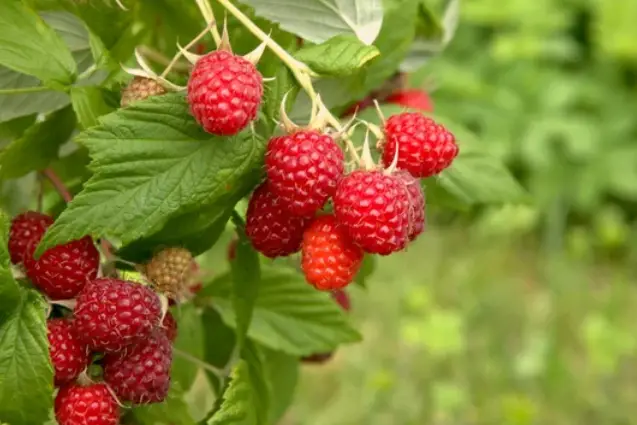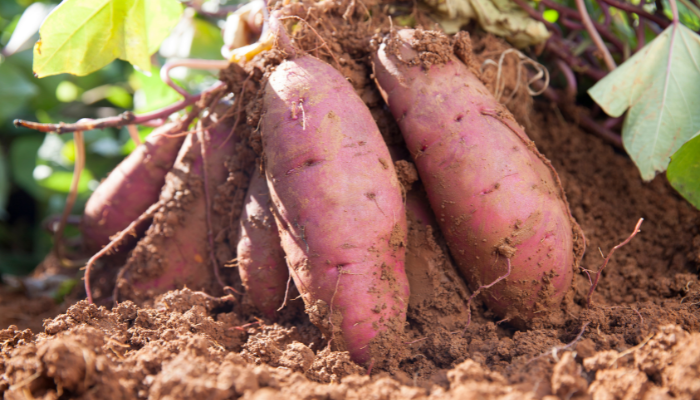How to Prevent and Treat Tomato Fungal Diseases with Fungicide
Tomatoes are one of the most popular and rewarding crops to grow in your home garden. They are versatile, delicious, and nutritious. However, they are also prone to various fungal diseases that can ruin your harvest and affect your plants’ health. In this blog post, we will discuss some of the common fungal diseases that affect tomatoes, how to prevent them, and how to treat them with fungicides.
Common Tomato Fungal Diseases
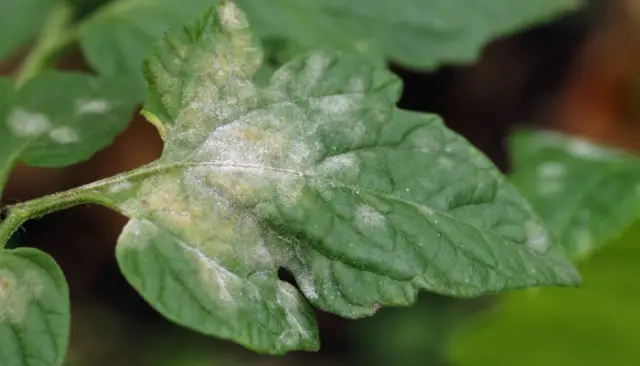
There are many types of fungi that can infect tomato plants, but some of the most common and damaging ones are:
- Early blight: This disease causes brown spots with concentric rings on the leaves, stems, and fruits of tomato plants. It can reduce the yield and quality of the tomatoes, and eventually kill the plant. Early blight is caused by the fungus Alternaria solani, which survives in the soil and on plant debris. It spreads by wind, rain, and insects.
- Late blight: This disease causes grayish-white patches on the leaves and stems, and brown, sunken lesions on the fruits of tomato plants. It can quickly destroy the entire plant and the crop. Late blight is caused by the fungus-like organism Phytophthora infestans, which also infects potatoes and other nightshade plants. It survives in the soil and on infected plant material. It spreads by wind, rain, and insects.
- Septoria leaf spot: This disease causes small, circular spots with dark borders and white centers on the lower leaves of tomato plants. It can cause defoliation and reduce the yield and quality of the tomatoes. Septoria leaf spot is caused by the fungus Septoria lycopersici, which survives in the soil and on plant debris. It spreads by rain, irrigation, and handling of plants.
- Anthracnose: This disease causes dark, sunken spots on the ripe fruits of tomato plants. It can cause rotting and cracking of the tomatoes, and make them unappealing and inedible. Anthracnose is caused by several species of fungi in the genus Colletotrichum, which survive in the soil and on infected plant material. It spreads by rain, irrigation, and handling of fruits.
How to Prevent Tomato Fungal Diseases
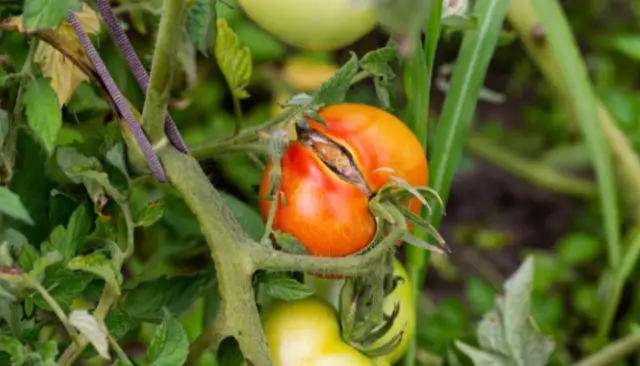
The best way to avoid tomato fungal diseases is to prevent them from occurring in the first place. Here are some tips to help you prevent fungal infections on your tomato plants:
- Choose resistant varieties: Some tomato varieties are more resistant to certain fungal diseases than others. Look for labels or descriptions that indicate resistance to early blight, late blight, Septoria leaf spot, anthracnose, or other diseases. For example, some resistant varieties are Celebrity, Mountain Fresh, Big Beef, and Defiant.
- Practice crop rotation: Do not plant tomatoes in the same spot where you planted tomatoes, potatoes, or other nightshade plants in the previous year. This will help reduce the chances of soil-borne fungi infecting your plants. Rotate your tomato plants with crops from different plant families, such as beans, peas, lettuce, or corn.
- Remove infected plants and debris: As soon as you notice any signs of fungal disease on your tomato plants, remove and dispose of the affected parts or the whole plant. Do not compost or leave them in the garden, as they can harbor and spread the fungi. Also, remove and discard any fallen leaves, fruits, or other plant debris from the garden, as they can serve as sources of infection.
- Avoid overhead watering: Watering your tomato plants from above can create wet conditions that favor fungal growth and spore dispersal. Instead, water your plants at the base, using a drip irrigation system, a soaker hose, or a watering can. Water your plants in the morning, so that the leaves can dry quickly during the day.
- Provide adequate spacing and ventilation: Plant your tomato plants at least 2 feet apart, and stake or cage them to keep them upright and off the ground. This will allow for good air circulation and sunlight penetration, which will help prevent fungal growth and infection. Prune your plants to remove any excess or diseased foliage, and avoid crowding your plants with other crops or weeds.
How to Treat Tomato Fungal Diseases with Fungicide
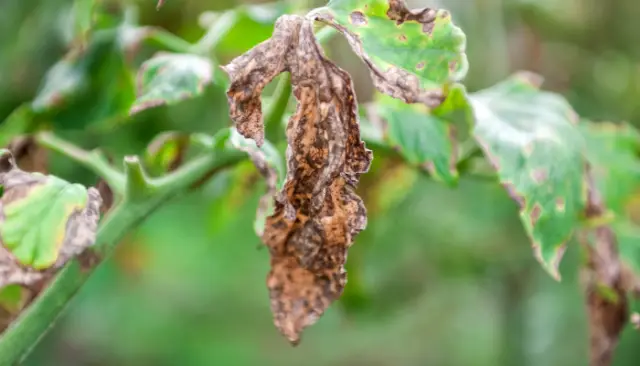
If you notice any signs of fungal disease on your tomato plants, you can try to treat them with fungicide. Fungicides are chemicals that kill or inhibit the growth of fungi. They can be applied as sprays, dusts, or granules, depending on the product and the disease. Here are some of the best fungicides for tomato plants.
- Bonide Mancozeb Fungicide Concentrate: This is a broad-spectrum fungicide that can prevent and control early blight, late blight, Septoria leaf spot, anthracnose, and other diseases. It contains the active ingredient mancozeb, which interferes with the fungi’s metabolism and cell division. It can be applied as a spray every 7 to 10 days, starting from the time of transplanting until the end of the season. It is compatible with most other pesticides and fertilizers.
- Bonide Copper Fungicide RTU: This is a ready-to-use fungicide that can prevent and control early blight, late blight, Septoria leaf spot, anthracnose, and other diseases. It contains the active ingredient copper octanoate, which damages the fungi’s cell membranes and enzymes. It can be applied as a spray every 7 to 10 days, or as needed. It is safe for organic gardening and does not harm beneficial insects.
- Garden Safe Fungicide Ready-To-Use: This is a natural fungicide that can prevent and control early blight, late blight, Septoria leaf spot, anthracnose, and other diseases. It contains the active ingredient neem oil, which is derived from the seeds of the neem tree. It acts as an antifungal, insecticidal, and repellent agent. It can be applied as a spray every 7 to 14 days, or as needed. It is safe for organic gardening and does not harm beneficial insects.
- Spectracide Immunox Fungicide Spray Concentrate: This is a systemic fungicide that can prevent and control early blight, late blight, Septoria leaf spot, anthracnose, and other diseases. It contains the active ingredient myclobutanil, which inhibits the fungi’s sterol synthesis. It can be applied as a spray every 14 days, or as needed. It is absorbed by the plant and protects it from the inside. It is compatible with most other pesticides and fertilizers.
- Daconil Fungicide Concentrate: This is a contact fungicide that can prevent and control early blight, late blight, Septoria leaf spot, anthracnose, and other diseases. It contains the active ingredient chlorothalonil, which disrupts the fungi’s respiration and energy production. It can be applied as a spray every 7 to 14 days, or as needed. It forms a protective barrier on the plant surface and does not wash off easily. It is compatible with most other pesticides and fertilizers.
When using any fungicide, make sure to read and follow the label directions carefully. Wear protective clothing and equipment, and avoid contact with skin, eyes, and mouth. Do not apply fungicides in windy, rainy, or hot conditions, as they can drift, wash off, or burn the plants. Do not apply fungicides more often or at higher rates than recommended, as they can cause phytotoxicity or resistance. Do not apply fungicides within the pre-harvest interval, as they can leave residues on the fruits. Always wash your fruits thoroughly before eating or processing them.
Conclusion
Tomato fungal diseases can be a serious threat to your tomato plants and your harvest. However, by following some preventive measures and using some effective fungicides, you can protect your plants and enjoy your tomatoes. We hope this blog post has been helpful and informative for you. If you have any questions or comments, please feel free to leave them below. Happy gardening!
FAQs on The Topic of Fungicide For Tomato Plants
Q: What is a fungicide?
-
- A: A fungicide is a chemical that kills or inhibits the growth of fungi. Fungi are organisms that cause diseases on plants, animals, and humans. Some common fungal diseases on tomato plants are early blight, late blight, Septoria leaf spot, and anthracnose.
Q: Why do I need to use fungicide on my tomato plants?
-
- A: Fungicide can help you prevent and control fungal diseases on your tomato plants. Fungal diseases can reduce the yield and quality of your tomatoes, and even kill your plants. Fungicide can protect your plants and your harvest from fungal infections.
Q: When should I apply fungicide on my tomato plants?
-
- A: The best time to apply fungicide on your tomato plants is before the symptoms of fungal diseases appear. This is because fungicides are more effective at preventing than curing fungal diseases. You should apply fungicide on your tomato plants every 7 to 14 days, depending on the product and the disease. You should also apply fungicide after transplanting, pruning, or harvesting, as these activities can create wounds that can be infected by fungi.
Q: How do I apply fungicide on my tomato plants?
-
- A: The most common way to apply fungicide on your tomato plants is by spraying. You can use a hand-held sprayer, a hose-end sprayer, or a backpack sprayer, depending on the size of your garden. You should follow the label directions of the fungicide product carefully, and mix the right amount of fungicide with water. You should spray the fungicide evenly on all parts of the plant, especially the lower leaves, stems, and fruits. You should avoid spraying in windy, rainy, or hot conditions, as this can reduce the effectiveness of the fungicide or damage the plants.
Q: What are some of the best fungicides for tomato plants?
-
- A: Some of the best fungicides for tomato plants are Bonide Mancozeb Fungicide Concentrate, Bonide Copper Fungicide RTU, Garden Safe Fungicide Ready-To-Use, Spectracide Immunox Fungicide Spray Concentrate, and Daconil Fungicide Concentrate. These fungicides can prevent and control various fungal diseases on tomato plants, such as early blight, late blight, Septoria leaf spot, and anthracnose. They have different active ingredients, modes of action, and application methods, so you should choose the one that suits your needs and preferences.
Q: Are fungicides safe for humans, animals, and the environment?
-
- A: Fungicides are generally safe for humans, animals, and the environment, if used according to the label directions. However, some fungicides can be toxic or harmful if ingested, inhaled, or contacted with skin, eyes, or mouth. Therefore, you should wear protective clothing and equipment, such as gloves, goggles, mask, and hat, when handling or applying fungicides. You should also keep children, pets, and wildlife away from the treated area, and wash your hands and tools thoroughly after using fungicides. You should also avoid applying fungicides near water sources, such as ponds, streams, or wells, as they can contaminate the water and harm aquatic life.
Q: How long do I have to wait before harvesting or eating my tomatoes after applying fungicide?
-
- A: The waiting period between applying fungicide and harvesting or eating your tomatoes depends on the fungicide product and the disease. You should check the label of the fungicide product for the pre-harvest interval, which is the minimum number of days you have to wait before harvesting or eating your tomatoes. The pre-harvest interval can range from 0 to 14 days, depending on the fungicide and the disease. You should always follow the label directions and respect the pre-harvest interval, as this will ensure the safety and quality of your tomatoes.
Q: Can I use organic or natural fungicides on my tomato plants?
-
- A: Yes, you can use organic or natural fungicides on your tomato plants, if you prefer. Organic or natural fungicides are derived from natural sources, such as plants, minerals, or microorganisms. They are usually safer and more environmentally friendly than synthetic fungicides, but they may be less effective or more expensive. Some examples of organic or natural fungicides are neem oil, copper, sulfur, baking soda, and vinegar. You should follow the same precautions and guidelines as synthetic fungicides when using organic or natural fungicides on your tomato plants.
Q: Can I make my own fungicide at home?
-
- A: Yes, you can make your own fungicide at home, if you have the right ingredients and equipment. However, homemade fungicides may not be as effective or reliable as commercial fungicides, and they may have unknown or undesirable effects on your plants or health. Therefore, you should use homemade fungicides with caution and at your own risk. Some examples of homemade fungicides are milk, garlic, aspirin, and hydrogen peroxide. You should research the recipes and methods of making and applying homemade fungicides before trying them on your tomato plants.
Q: What else can I do to prevent and treat fungal diseases on my tomato plants?
-
- A: Besides using fungicides, you can also prevent and treat fungal diseases on your tomato plants by following some cultural practices, such as:
- Choose resistant varieties: Some tomato varieties are more resistant to certain fungal diseases than others. Look for labels or descriptions that indicate resistance to early blight, late blight, Septoria leaf spot, anthracnose, or other diseases.
- Practice crop rotation: Do not plant tomatoes in the same spot where you planted tomatoes, potatoes, or other nightshade plants in the previous year. This will help reduce the chances of soil-borne fungi infecting your plants. Rotate your tomato plants with crops from different plant families, such as beans, peas, lettuce, or corn.
- Remove infected plants and debris: As soon as you notice any signs of fungal disease on your tomato plants, remove and dispose of the affected parts or the whole plant. Do not compost or leave them in the garden, as they can harbor and spread the fungi. Also, remove and discard any fallen leaves, fruits, or other plant debris from the garden, as they can serve as sources of infection.
- Avoid overhead watering: Watering your tomato plants from above can create wet conditions that favor fungal growth and spore dispersal. Instead, water your plants at the base, using a drip irrigation system, a soaker hose, or a watering can. Water your plants in the morning, so that the leaves can dry quickly during the day.
- Provide adequate spacing and ventilation: Plant your tomato plants at least 2 feet apart, and stake or cage them to keep them upright and off the ground. This will allow for good air circulation and sunlight penetration, which will help prevent fungal growth and infection. Prune your plants to remove any excess or diseased foliage, and avoid crowding your plants with other crops or weeds.
- A: Besides using fungicides, you can also prevent and treat fungal diseases on your tomato plants by following some cultural practices, such as:




